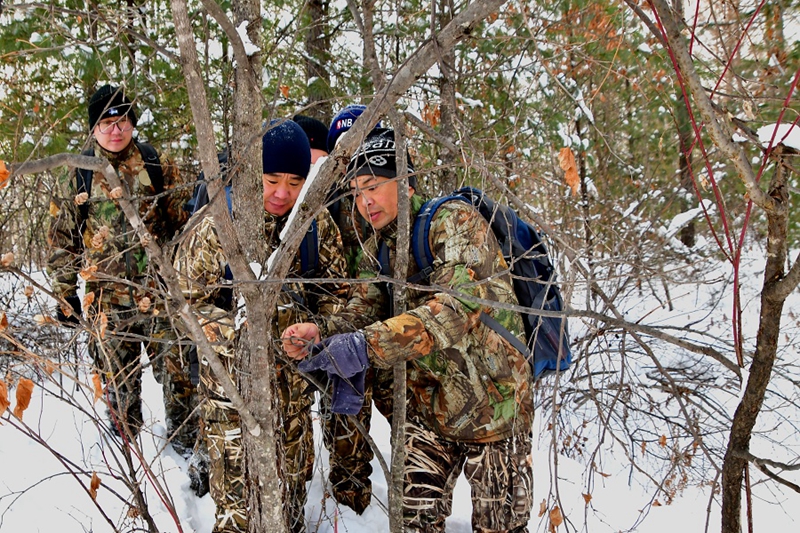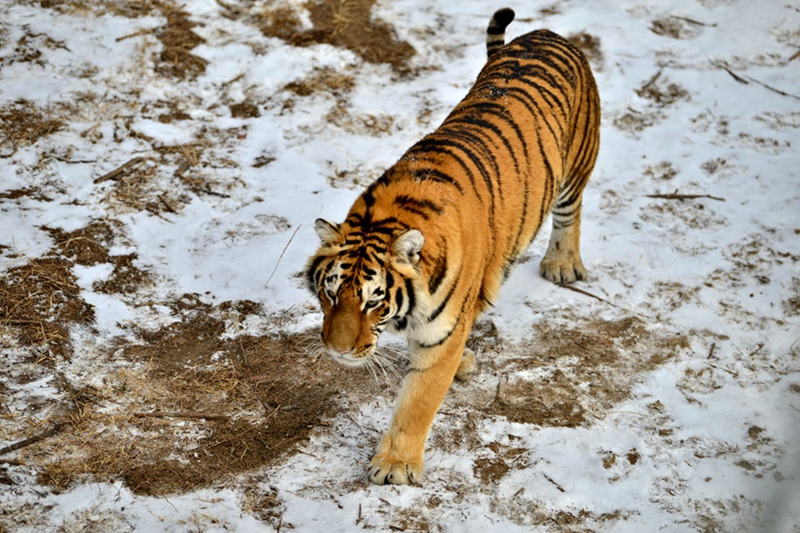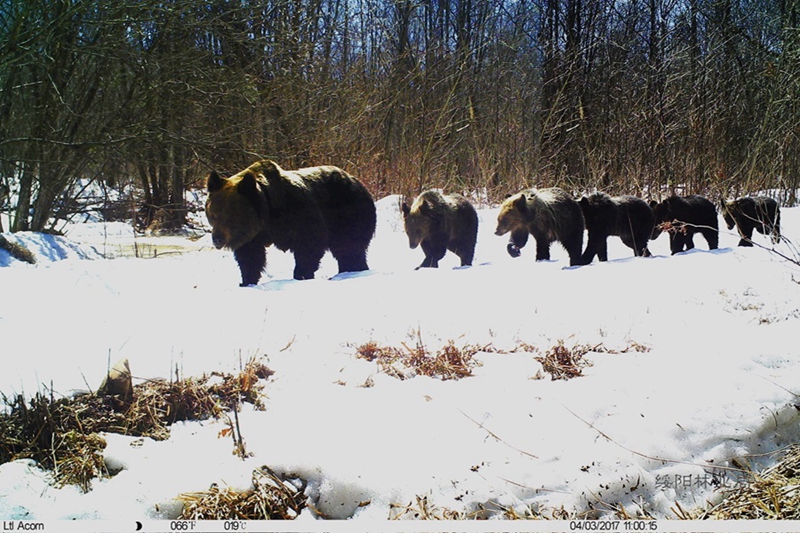For Li Dongwei, a ranger at the Northeast China Tiger and Leopard National Park, the most exciting thing is to find the feces of Siberian tigers in the wild. He doesn’t mind the stinky odor at all. “When I find their droppings, I know that the Siberian tigers have been there, and we can also check their health through studying the feces,” smiled Li.
At 41, Li resides in Hunchun City, northeastern China’s Jilin Province. The city is part of the core zone of the Northeast China Tiger and Leopard National Park, which covers 14,100 square kilometers, including much of the tigers’ migration route to Russia. The natural park is the most vital habitat and breeding ground for Siberian tigers and Amur leopards, boasting the largest population of these big cats in China.

Rangers clear snares. (The Northeast China Tiger and Leopard National Park)
More Participation
In 2012, Li, who was engaged in farming in his hometown, joined the local wildlife conservation volunteer team. Over the past decade, he has witnessed the changes in the Northeast China Tiger and Leopard National Park. In 2017, the area became a pilot national park, incorporating 19 nature reserves including Hunchun. In 2021, the Northeast China Tiger and Leopard National Park was formally established, an impressive milestone achieved in just four years. Within this period, the Hunchun region witnessed a growing population of the big cats, bringing back the scene of “tigers in every mountain” as in days past.
Much of this change can be attributed to the dedication of people like Li and his colleagues. Over the years, nearly 7,000 rangers have been active within the national park to combat wildlife poaching. “Through comprehensive patrols, the threat of poaching within the park has significantly decreased,” said Li. “We’re finding 97 percent fewer snares now.”
Many former hunters have also joined the patrol work. Yu Guichen, now 71, started learning hunting from village elders at 16. By 1996, before Jilin Province implemented a hunting ban, he had already noticed a significant decline in the number of animals in the wild. In 2015, he began to join in the conservation of Siberian tigers and Amur leopards. Every winter, from November to February the following year, he joins rangers from Hunchun Municipal Forestry Bureau to conduct mountain patrols.
His years of hunting experience enable him to spot snares that others might miss, earning him admiration from the younger rangers. Yu is generous in sharing his experience. “Animals are like people,” he said. “They prefer walking on flat ground. Tigers, leopards, and other animals wander along mountain ridges, just like domestic animals. So, poachers often set traps by the trees on the roadsides.”
Today, the patrol team of the Northeast China Tiger and Leopard National Park is expanding, with many young people joining up. Yu Shaopeng, 25, is the youngest ranger at Dahuanggou Forest Farm, also part of the national park. In addition to regular patrols, he is also responsible for monitoring the habitats of wild animals, preventing forest fires, and guarding against the invasion of foreign species. Sometimes he also guards the national park’s entrance. If he notices human activity in areas that tigers and leopards frequent, he immediately ventures into the mountains to discourage it.
Yu aspires to foster the “next generation” of rangers. “The previous mission of rangers focused on combating theft and poaching as well as protecting the safety of wildlife in the forest,” he said. “However, now our goal is to promote harmonious coexistence between humans and nature.”

Siberian tiger. (Chen Xiaocai)
Technology Empowered
By observing the footprints of tigers and leopards, Zhao Yan, deputy director of the Research and Monitoring Center at the Hunchun Branch of the Northeast China Tiger and Leopard National Park, can distinguish between males and females and track their migration routes. When he hears the roar of a tiger, Zhao leaves the area immediately. Having worked outdoors year-round, he is already well-versed in the habits of Siberian tigers and Amur leopards.
In the spring of 2015, commercial logging of natural forests was completely halted in all key state-owned forest areas in northeastern China. As a result, at 30, Zhao transitioned from a forestry worker to a ranger. Later, he took on the role as head of the Research and Monitoring Center.
Most of the year, Zhao spends his time conducting scientific observations and patrolling the mountains. One crucial task of his work is to install infrared cameras in areas where tigers and leopards are frequently spotted. These cameras are powered by solar panels and automatically activate whenever animals appear in front of the lens, capturing real-time footage of their activities.
Regular camera maintenance is also part of Zhao’s daily duties. “Sometimes, the cameras are obstructed by tall weeds, or damaged by falling tree branches,” he said. “Occasionally, mischievous ‘big cats’ curiously approach the cameras, stare and examine them, and then playfully give the cameras a slap, toppling them over.”
Over 20,000 infrared cameras for real-time data transmission now operate within the national park. As of October 2022, the park had captured over 30,000 images of Siberian tigers and Amur leopards. The images are wirelessly transmitted to the Monitoring and Research Center. Through advanced technology, researchers can analyze the status of all wildlife within the park based on these images.
On October 12, 2022, the national park celebrated its first anniversary. By then, monitoring efforts indicated a significant increase in the population of wild tigers and leopards. The number of tigers had grown from 27 in 2017 when the park was put into trial operation to 50, and the population of leopards grew from 42 to 60. Moreover, they found over 10 new tiger cubs and seven new leopard cubs, demonstrating a stable growth in their populations.
Furthermore, monitoring personnel noticed a substantial expansion in the distribution scope of female tigers and leopards into the core areas of the national park’s pilot zone. The populations of the three main prey species of Siberian tigers and Amur leopards—the boar, the sika deer, and the roe deer—had all doubled. Additionally, species such as the river deer and the goral, which had disappeared for many years, have been spotted once again in the region.
“In this national park, tigers and leopards are the top predators in the food chain, and their status directly reflects the situation of the regional ecosystem,” said Zhao. “Protecting the tigers and leopards is also about safeguarding biodiversity and improving the environment on which people depend for their livelihoods. The return of tigers indicates that the ecology is getting better.”

A brown bear family. (The Northeast China Tiger and Leopard National Park)















